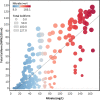Nitrate in groundwater and agricultural products: intake and risk assessment in northeastern Iran
- PMID: 35691946
- PMCID: PMC9587111
- DOI: 10.1007/s11356-022-20831-9
Nitrate in groundwater and agricultural products: intake and risk assessment in northeastern Iran
Abstract
The suitability of groundwater and agricultural products for human consumption requires determining levels and assessing the health risks associated with potential pollutants. Here, particularly pollution with nitrate still remains a challenge, especially for those urban areas suffering from insufficient sewage collection systems, resulting in contaminating soil, endangering food safety, and deteriorating drinking water quality. In the present study, nitrate concentrations in the commonly consumed fruit and vegetable species were determined, and the results, together with the groundwater nitrate levels, were used to assess the associated health risks for Mashhad city residents. For this assessment, 261 water samples and 16 produce types were used to compute the daily intake of nitrate. Nitrate in groundwater was analyzed using a spectrophotometer, and produce species were examined using High-Performance Liquid Chromatography. Ward's hierarchical cluster analysis was applied for categorizing produce samples with regard to their nitrate content. Additionally, to account for the sanitation hazards associated with groundwater quality for drinking purposes, total coliform and turbidity were also assessed using the membrane filter (MF) technique and a nephelometer, respectively. Nitrate concentrations exceeded the prescribed permissible limits in 42% of the groundwater wells. The outcomes also exhibit significantly higher nitrate accumulation levels in root-tuber vegetables and leafy vegetables compared to fruit vegetables and fruits. Using cluster analysis, the accumulation of nitrate in vegetables and fruits was categorized into four clusters, specifying that radish contributes to 65.8% of the total content of nitrate in all samples. The Estimated Daily Intake (EDI) of nitrate and Health Risk Index (HRI) associated with consumption of groundwater exceeded the prescribed limit for the children's target group in Mashhad's south and central parts. Likewise, EDI and HRI values for produce consumption, in most samples, were found to be in the tolerable range, except for radish, lettuce, and cabbage, potentially posing risks for both children and adult consumers. The total coliforms in groundwater were found to violate the prescribed limit at 78.93% of the sampling locations and were generally much higher over the city's central and southern areas. A relatively strong correlation (R2 = 0.6307) between total coliform and nitrate concentrations suggests the release of anthropogenic pollution (i.e., sewage and manure) in the central and southern Mashhad.
Keywords: Drinking water; Fruits and vegetables; Groundwater; Health risk assessment; Nitrate; Water quality.
© 2022. The Author(s).
Conflict of interest statement
The authors declare no competing interests.
Figures








Similar articles
-
Nitrate in drinking water and vegetables: intake and risk assessment in rural and urban areas of Nagpur and Bhandara districts of India.Environ Sci Pollut Res Int. 2019 Jan;26(3):2026-2037. doi: 10.1007/s11356-017-9195-y. Epub 2017 Jun 6. Environ Sci Pollut Res Int. 2019. PMID: 28589276
-
Study of nitrate levels in fruits and vegetables to assess the potential health risks in Bangladesh.Sci Rep. 2021 Feb 25;11(1):4704. doi: 10.1038/s41598-021-84032-z. Sci Rep. 2021. PMID: 33633239 Free PMC article.
-
Judging the sources of inferior groundwater quality and health risk problems through intake of groundwater nitrate and fluoride from a rural part of Telangana, India.Environ Sci Pollut Res Int. 2022 Jul;29(32):49070-49091. doi: 10.1007/s11356-022-18967-9. Epub 2022 Feb 25. Environ Sci Pollut Res Int. 2022. PMID: 35212895
-
Sources, pathways, and relative risks of contaminants in surface water and groundwater: a perspective prepared for the Walkerton inquiry.J Toxicol Environ Health A. 2002 Jan 11;65(1):1-142. doi: 10.1080/152873902753338572. J Toxicol Environ Health A. 2002. PMID: 11809004 Review.
-
The potential for a suite of isotope and chemical markers to differentiate sources of nitrate contamination: a review.Water Res. 2012 May 1;46(7):2023-41. doi: 10.1016/j.watres.2012.01.044. Epub 2012 Feb 9. Water Res. 2012. PMID: 22348997 Review.
Cited by
-
The impact of environmental factors and contaminants on thyroid function and disease from fetal to adult life: current evidence and future directions.Front Endocrinol (Lausanne). 2024 Jun 19;15:1429884. doi: 10.3389/fendo.2024.1429884. eCollection 2024. Front Endocrinol (Lausanne). 2024. PMID: 38962683 Free PMC article. Review.
-
Assessment of quaternary aquifer pollution sensitivity using modified DRASTIC models around stressed Canal in Eastern Nile delta, Egypt.Sci Rep. 2025 Jul 13;15(1):25287. doi: 10.1038/s41598-025-09489-8. Sci Rep. 2025. PMID: 40652032 Free PMC article.
-
Health Risk Assessment of Nitrate in Drinking Water with Potential Source Identification: A Case Study in Almaty, Kazakhstan.Int J Environ Res Public Health. 2023 Dec 30;21(1):55. doi: 10.3390/ijerph21010055. Int J Environ Res Public Health. 2023. PMID: 38248520 Free PMC article.
-
Human health risk of nitrate in groundwater of Tehran-Karaj plain, Iran.Sci Rep. 2024 Apr 3;14(1):7830. doi: 10.1038/s41598-024-58290-6. Sci Rep. 2024. PMID: 38570538 Free PMC article.
References
-
- Abdulrazak S, Otie D, Oniwapele YA. Concentration of nitrate and nitrite in some selected cereals sourced within Kaduna state, Nigeria. Online J. Anim. Feed Res. 2014;4:37–41.
-
- Abtahi M, Fakhri Y, Oliveri Conti G, Ferrante M, Taghavi M, Tavakoli J, Heshmati A, Keramati H, Moradi B, Amanidaz N. The concentration of BTEX in the air of Tehran: a systematic review-meta analysis and risk assessment. Intl J Environ Res Pub Health. 2018;15:1837. doi: 10.3390/ijerph15091837. - DOI - PMC - PubMed
-
- Amr A, Hadidi N. Effect of cultivar and harvest date on nitrate (NO3) and nitrite (NO2) content of selected vegetables grown under open field and greenhouse conditions in Jordan. J Food Compos Anal. 2001;14:59–67. doi: 10.1006/jfca.2000.0950. - DOI
-
- APHA . Standard methods for the examination of water and wastewater. 22. San Francisco: American Public Health Association; 2012.
-
- Ayaz A, Topcu A, Yurttagul M. Survey of nitrate and nitrite levels of fresh vegetables in Turkey. J Food Technol. 2007;5:177–179.
MeSH terms
Substances
LinkOut - more resources
Full Text Sources
Medical

